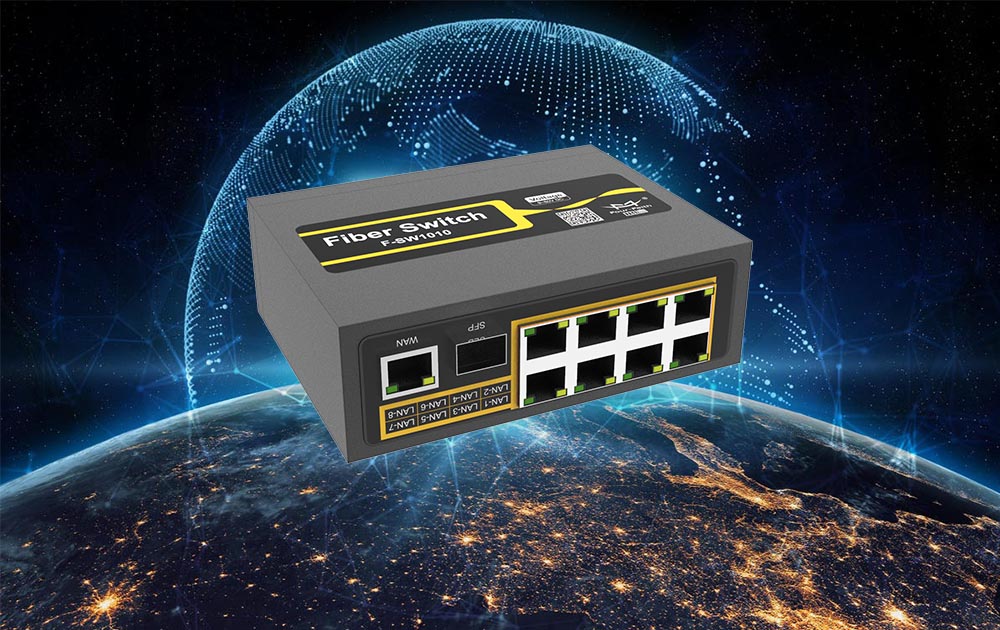Fiber optic converter is a module that converts serial port or other interface into optical fiber interface. Optical fiber converter is divided into multi-mode fiber conversion and single-mode fiber conversion; generally, the maximum distance of multi-mode fiber converters is 4KM; single-mode is 40KM. Single-mode and multi-mode can also be converted to each other to realize the networking function of multi-machine communication and relay conversion.
1. Detailed introduction of fiber optic converter
Optical fiber converter is an Ethernet transmission media conversion unit that interchanges short-distance twisted-pair electrical signals with long-distance optical signals. It is also called a fiber converter in many places. The product is generally used in the actual network environment where the Ethernet cable cannot be covered and the transmission distance must be extended by using optical fiber, and is usually located in the access layer application of the broadband metropolitan area network; such as: high-definition video image transmission for monitoring and security engineering; Helping to connect the last mile of fiber to the metro network and beyond has also played a huge role.
2. Principle of optical fiber converter
Optical fiber converter, also known as single-port optical transceiver, is a product designed for special user environments. It uses a pair of optical fibers to perform single E1 or single V.35 or single 10BaseT point-to-point optical transmission terminal equipment. As the relay transmission equipment of the local network, the equipment is suitable for the optical fiber terminal transmission equipment of the base station and the leased line equipment. For multi-port optical transceivers, it is generally called "optical transceiver", and for single-port optical transceivers, it is generally used at the user end, and its work is similar to the baseband MODEM commonly used for WAN dedicated line (circuit) networking.
Nowadays, when transmitting signals over long distances, they are all transmitted by optical fibers. The wider the transmission bandwidth of optical fibers, the better the stability. This requires converting the electrical signals generated by computers or telephones or faxes (we know that these electronic devices generate electronic signals) into optical signals before they can be transmitted in the optical fiber. This is the optical fiber converter, which can not only convert the electrical signals Converted into optical signals, optical signals can also be converted into electrical signals.
The other hand, when the optical path of the optical fiber transceiver is disconnected, the electrical port on the other end of most products will remain open, so upper-layer devices such as routers, switches, etc. will still continue to send packets to the electrical port, resulting in unreachable data. . It is hoped that the majority of equipment providers can realize automatic switching on the optical fiber transceiver. When the optical path is down, the electrical port will automatically alarm upward, and prevent the upper-layer equipment from continuing to send data to the port, and enable redundant links to ensure uninterrupted services.
Secondly, the optical fiber transceiver itself should be able to better adapt to the actual network environment. In practical projects, the use of optical fiber transceivers is mostly in the corridor or outdoors, and the power supply situation is very complicated. At the same time, due to the ultra-high temperature and ultra-low temperature weather conditions in many parts of the country, the impact of lightning strikes and electromagnetic interference is also real, all of which have a great impact on outdoor equipment such as transceivers, which requires equipment providers to be in key elements. Device adoption, circuit layout and soldering, and structural design must all be meticulous and rigorous.
3. Advantages of fiber optic converters
3.1 Longer transmission distance: up to 80Km, or even further (120Km).
3.2 Support video lossless regeneration relay, so multi-level transmission mode can be adopted.
3.3 Less interference from the environment and high transmission quality.
3.4 The supported signal capacity can reach 16 channels or even more (32 channels, 64 channels).
3.5 What is a fiber optic converter
4. The role of optical fiber converters
Optical transceivers are generally used in practical network environments where Ethernet cables cannot cover and optical fibers must be used to extend transmission distances, and they also play a huge role in helping to connect the last mile of optical fiber to the metropolitan area network and beyond. effect. With fiber optic transceivers, it also provides an inexpensive solution for users who need to upgrade their systems from copper to fiber, for those who lack capital, manpower or time. The function of the fiber optic transceiver is to convert the electrical signal we want to send into an optical signal and send it out. At the same time, it can convert the received optical signal into an electrical signal and input it to our receiving end.




















